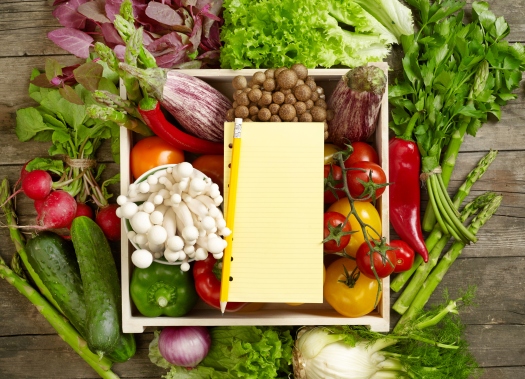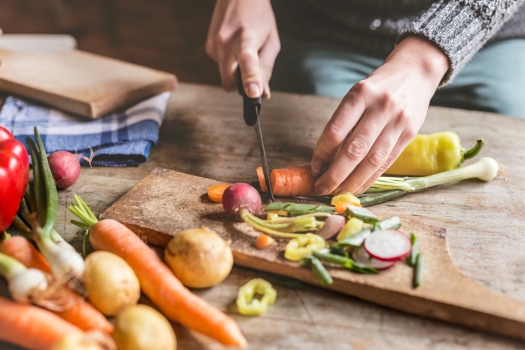One of the biggest secrets to successfully losing weight or improving your health is learning to cook your own food.
Constantly eating out at restaurants gives you little control over what and how much food you consume. Restaurants want to make your meal as tasty as possible and often add in a great deal of sugar, fat, and salt, creating dishes that are deceptively high in calories. The official nutritional information published by chain restaurants is helpful, but even these numbers can be inaccurate depending on the individual meal. Eating out every day also rapidly adds up to hundreds of dollars or more spent on food every month.
Cooking more of your food at home can save you both dollars and inches off your waistline. You can spend less money, eat a larger volume of food, prioritize protein and vegetables, and ensure that your food isn’t loaded up with extra sugar and fat. All of these things will help you feel more satisfied, avoid cravings, and make faster progress towards your goals.
Cooking more of your meals can be a difficult habit to form, which is why it’s important to use a system to formulate a plan of attack. In this article, I will outline my step-by-step approach to mastering meal prep. This includes drawing up a weekly meal plan, obtaining fresh ingredients by visiting the grocery store or setting up a delivery service, and then cooking your food in the most efficient manner possible.
Make a plan
The first step to successful meal prep is coming up with a plan. There is simply no way around this, especially if you are new to healthy eating or cooking. You need to spend some time figuring out what you want to eat for all of your meals before you go to the store. This will become easier with practice as you fall into a regular routine and develop a mental library of easy, healthy meals you enjoy.
I recommend repeating meals often for the sake of simplicity. Eating the same meals every day is a great way to keep control of your calories without much extra effort. It also helps reduce your food prep time since you will eventually become very efficient at making these repeat meals. I have personally found a lot of success eating the same breakfast and lunch every day and rotating through 5-10 regular dinner options. This allows me to to minimize daily prep time while still enjoying a variety of healthy, delicious meals in the evening.
If you are the kind of person who gets food boredom easily, you can use templates to add a bit of variety without changing the entire meal. For example, I make a big salad for lunch every day. The salad always contains chicken, salmon, or tuna along with plenty of vegetables and a simple homemade dressing. I can change up the protein, vegetable selections, and dressing for just enough variety from day to day without adding any time to my preparation.
If you are relatively new to cooking or simply want to expand your arsenal of regular meals, try out one new recipe each week. Look for recipes that are simple and predominantly feature proteins and vegetables. If you aren’t up for following an entire recipe but still want to diversify your cooking, try purchasing one new vegetable or protein source each week. Look up an easy preparation method, such as steaming vegetables or grilling proteins, or add the new food to a dish you are already familiar with such as roasted vegetables, stir fry, or salad. If you like the way the food tastes and it is easy for you to prepare, add it into your regular rotation.

Credit: iStock 526728754
Once you have created your meal plan, write down all the ingredients you need to purchase. Be specific about the amount of each item you need to avoid food waste. Do a quick mental inventory of your pantry and write down any items that are running low and may need to be replaced. These items could include oils, vinegar, spices, canned goods, rice, and other dry goods. If you are new to cooking and have a very limited pantry, try buying one new spice or other item each week.
The last step in meal planning is to decide when to eat what. Proteins such as steak and fish should be eaten earlier in the week, whereas pork and chicken typically last longer in your fridge. Certain vegetables and fruits are heartier and will last longer than others. If you know one of your meals takes more time to prepare, be sure to schedule it for a day when your schedule is more relaxed. I recommend purchasing certain items from the frozen aisle to ensure that you will have good food available whenever you need it. Keep a bag of frozen chicken or shrimp and some frozen vegetables in your freezer in case you run out of food and can’t make it to the store. Consider all of these details to ensure your weekly cooking goes as smoothly as possible.
Navigating the grocery store
Now that you have your meal plan, it’s time to hit the grocery store. If you have done the first part of planning well, this step should be relatively easy. However, I find that people often skip the planning stage and head right to the store. This is a huge mistake, especially if you are new to meal prep, prone to impulse junk food purchases, or tend to waste a lot of what you buy. You should always come armed with a list until you are very experienced with meal prep and shopping. A list ensures that you will get the best value for your dollar and gives you a buffer against cravings.
Go through the store, buying everything on your list and nothing more. Most of your purchases should be made from the perimeter of the grocery store where you will find the fresh produce, meat, seafood, eggs, and dairy items. Only venture into the aisles to purchase items you have specifically put on your shopping list. Take special care to avoid aisles that house problem foods for you including chips, candy, soda, and baked goods.
Whenever possible, don’t go to the grocery store on an empty stomach. Your hunger may fuel impulse purchases of junk food or cause you to buy more food than you actually need.
If you absolutely detest shopping or don’t have the time to go to the store, I recommend investing in a grocery delivery service such as Instacart or Peapod. These services allow you to submit grocery lists which are then delivered directly to your house. In addition to saving you time, these services make it more difficult for you to grab that bag of chips or candy bar at checkout.
You might also consider signing up for a meal delivery service for some or all of your weekly meals. These services range from delivering meals that are precooked and just need to be reheated to sending you boxes of ingredients with instructions on how to prepare the meal yourself. Many of my clients use these services with great success. There are many options available, so talk to your friends and do some research to determine which one might be a good fit for you.

Credit: iStock 480391926
Get cooking
After you have finished shopping, it’s time to prepare your food for the week. There are two approaches to this process: (1) cook all of your food for the week in one sitting; or (2) prepare one day of food at a time.
If you know your weeks are hectic and you would rather get everything done at once, I recommend setting aside a couple of hours to do all of your planning, shopping, and cooking on the weekend. If your weekends tend to be busier than your weeknights, or if you have a small refrigerator and can’t store a ton of food, prep one day at a time. Either approach can work as long as it fits into your schedule and lifestyle.
There are many tricks you can use to reduce cooking time. Batch cooking is an easy way to prepare many meals at once; it works especially well with dry grains, beans, legumes, and proteins. For example, you can bake several pounds of chicken at once and then divvy it up for individual meals.
If you are making a one-pot dish such as a chili, soup, or stew, try doubling the recipe to leave you with twice the food for the same amount of time and effort. You can also freeze some of these leftovers for quick and easy meals in the future.
The slow cooker is another one of my favorite tools for easy meal prep because it allows you to make a large amount of food with minimal effort. Simply drop in some protein, hearty vegetables, and spices and return several hours later to a delicious and balanced meal. You can also use the slow cooker to batch cook large amounts of protein, grains, and vegetables to eat at various meals throughout the week.
If you are prepping day by day, you can still do some work on the weekend to make each day easier. Try chopping vegetables and storing them in the fridge for easy access for salads, stir frys, and scrambled eggs. Hard boil a dozen eggs for quick breakfasts or snacks. Set aside time every night or morning to do your main cooking for the day. If you can’t find time, consider switching to a weekend prep.
Meal prep your way to better results
Cooking more of your food at home is one of the best ways to take control of your health and weight.
Set up a weekly meal prep ritual that helps you get into a routine of planning, shopping, and cooking more of your meals, and stick with it diligently for several months. It takes time to establish habits and you need to get used to the numerous steps that go into this process. Once you’ve been consistent for a while, you can tweak your process to make it work better for your life. Long-term success depends on these processes becoming automatic so you can eat healthy while devoting your energy and effort to living your fullest life.
If you want some help with meal prep, sign up in the box below to receive Eleven Easy Meal Templates, a totally free guide to my favorite quick, healthy, homemade meals.

